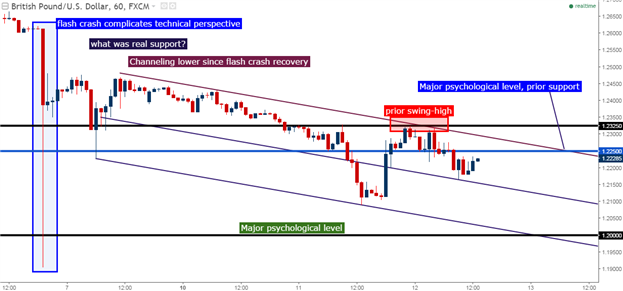To receive James Stanley’s Analysis directly via email, please sign up here.
Talking Points:
- GBP/USD Technical Strategy: Longer-term price action still bearish; post-Brexit range saw aggressive downside break.
- With GBP/USD working towards 30-year lows, there is little by way of ‘usable’ technical levels here for traders.
- If you’re looking for trading ideas, check out our Trading Guides; they’re free and updated for Q4.
In our last article, we looked at the breakdown in the British Pound after fears of a ‘hard Brexit’ scenario began to push Sterling prices lower after breaching support around the 1.3000-handle. And since that last article, not much has improved for spot rates in Sterling. One of the few positives might be taken from the fact that a flash crash took place on Friday… and while the flash crash itself had little by way of positivity for the Pound, it did finally produce a support level that has yet to give way.
If anything, that flash crash on Friday should serve as a warning to traders speculating in the Cable. The fact that this move took place towards the latter portion of the afternoon on a Friday indicates that it was likely resultant of abysmal liquidity. And this makes sense, given that institutional traders are just as likely if not more so to be risk averse around a situation for which there is no historical precedence.
In the near-term this is likely a market that will continue to be driven by headlines. For traders, that’s a dangerous thing, as headlines are utterly unpredictable; and these unpredictable developments can still trigger stops and run counter to trend-side positions. As we had written in our last article, given the veracity of the move lower, traders would likely want to retain a bearish bias on the pair; electing for shorter-term, momentum based strategies in the effort of controlling risk levels.
This morning presented another example of why managing risk in bleeding markets can be so incredibly difficult. After newly-installed Prime Minister Theresa May indicated that she may include British Parliament in the Brexit process, thereby reducing the likelihood of the hardest ‘hard Brexit’ scenario; GBP/USD rallied by more than 200 pips over just a few hours.
So moving forward traders are going to want to exercise caution and vigilance if trading anything around the British Pound: This market is likely going to continue to be pushed around by headlines until more certain information is agreed upon for how the Brexit process may proceed. And given that there is no historical precedent, we don’t even have a playbook or template to apply here. While this debate rages through British Politics, banks are likely going to attempt to retain a risk-averse stance, and that means that traders are likely looking at less-liquid environments around Sterling in the near-term.
What this means: Be extra careful with reversal strategies, manage risk on trend-side strategies and if taking positions around GBP – make sure that you’re comfortable with your stop so that if it gets hit, you’re not second guessing your previous decision to take the trade.

Chart prepared by James Stanley
--- Written by James Stanley, Analyst for DailyFX.com
To receive James Stanley’s analysis directly via email, please SIGN UP HERE
Contact and follow James on Twitter: @JStanleyFX







